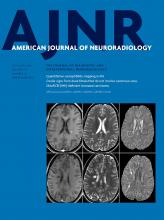Abstract
BACKGROUND AND PURPOSE: Idiopathic intracranial hypertension has been associated with dural venous sinus stenosis in some patients, but the hemodynamic environment of the dural venous sinuses has not been quantitatively described. Here, we present the first such computational fluid dynamics model by using patient-specific blood pressure measurements.
MATERIALS AND METHODS: Six patients with idiopathic intracranial hypertension and at least 1 stenosis or atresia at the transverse/sigmoid sinus junction underwent MR venography followed by cerebral venography and manometry throughout the dural venous sinuses. Patient-specific computational fluid dynamics models were created by using MR venography anatomy, with venous pressure measurements as boundary conditions. Blood flow and wall shear stress were calculated for each patient.
RESULTS: Computational models of the dural venous sinuses were successfully reconstructed in all 6 patients with patient-specific boundary conditions. Three patients demonstrated a pathologic pressure gradient (≥8 mm Hg) across 4 dural venous sinus stenoses. Small sample size precludes statistical comparisons, but average overall flow throughout the dural venous sinuses of patients with pathologic pressure gradients was higher than in those without them (1041.00 ± 506.52 mL/min versus 358.00 ± 190.95 mL/min). Wall shear stress was also higher across stenoses in patients with pathologic pressure gradients (37.66 ± 48.39 Pa versus 7.02 ± 13.60 Pa).
CONCLUSIONS: The hemodynamic environment of the dural venous sinuses can be computationally modeled by using patient-specific anatomy and physiologic measurements in patients with idiopathic intracranial hypertension. There was substantially higher blood flow and wall shear stress in patients with pathologic pressure gradients.
ABBREVIATIONS:
- CFD
- computational fluid dynamics
- IIH
- idiopathic intracranial hypertension
- WSS
- wall shear stress
- © 2016 by American Journal of Neuroradiology
Indicates open access to non-subscribers at www.ajnr.org












